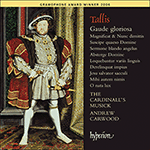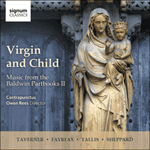One of the most difficult tasks facing the Tallis scholar is any attempt to impose chronological order on the composer’s output. The five-part Latin
Magnificat and
Nunc dimittis are especially problematic. They survive in a unique Elizabethan source but their style and form point to an earlier date of composition. Tallis adopts the usual practice of alternating chant with polyphony in the pre-Reformation style but there is no use of cantus firmus nor faburden. Furthermore the old-style melismas are not in evidence and there is a much greater use of syllabic writing, nor are there any sections for soloists or reduced forces as one might expect. Here also is a rather less euphonious Tallis at work than can be seen in the pieces more securely attributed to the reigns of Mary and Elizabeth. So the evidence seems to point to a compositional date late in Henry VIII’s reign.
from notes by Andrew Carwood © 2005
Lorsque l’on est spécialiste de Tallis, une des tâches les plus ardues consiste à tenter d’imposer un ordre chronologique à la production de ce compositeur, le
Magnificat à cinq parties et le
Nunc dimittis étant, à cet égard, particulièrement problématiques. Tous deux nous sont conservés dans une unique source élisabéthaine, mais leur style et leur forme indiquent une date de composition antérieure. Conformément à la pratique en vigueur, Tallis fait alterner le plain-chant et la polyphonie, dans le style de la pré-Réforme, mais n’utilise ni le cantus firmus ni le faburden. En outre, les mélismes de l’ancien style sont quasi absents, tandis que le recours à l’écriture syllabique est bien plus fréquent; contre toute attente, il n’y a pas non plus de sections adressées aux solistes ou à des forces réduites. Nous sommes ici en présence d’un Tallis moins euphonique que dans les pièces plus sûrement attribuées aux règnes de Marie et d’Élisabeth. Tous les indices s’accordent donc à situer le
Magnificat et
Nunc dimittis à la fin du règne de Henri VIII.
extrait des notes rédigées par Andrew Carwood © 2005
Français: Hypérion
Eine der schwersten Aufgaben für den Tallis Forscher ist es, das Oeuvre des Komponisten in eine chronologische Reihenfolge zu bringen. Das fünfstimmige lateinische
Magnificat und
Nunc dimittis sind besonders problematisch. Sie sind in einer einzigartigen elisabethanischen Quelle überliefert, doch weisen Stil und Form auf ein früheres Kompositionsdatum hin. Tallis arbeitet hier mit der üblichen Technik, bei der Choral und Polyphonie im vorreformatorischen Stil alterniert werden, doch wird weder ein Cantus firmus noch der Faburden eingesetzt. Zudem sind keinerlei Melismen des alten Stils erkennbar sondern viel mehr syllabische Textvertonung, noch gibt es Passagen für Solisten oder kleinere Besetzungen, wie man es erwarten könnte. Außerdem haben wir es hier mit einem weniger wohlklingenden Tallis zu tun als in den Werken, die der Herrschaft Marias und Elisabeths mit größerer Sicherheit zugeordnet werden können. Daher scheint alles darauf hinzuweisen, dass diese beiden Werke wohl noch unter Heinrich VIII. entstanden.
aus dem Begleittext von Andrew Carwood © 2005
Deutsch: Viola Scheffel


 Tallis: Gaude gloriosa & other sacred music
Tallis: Gaude gloriosa & other sacred music Virgin and Child
Virgin and Child
